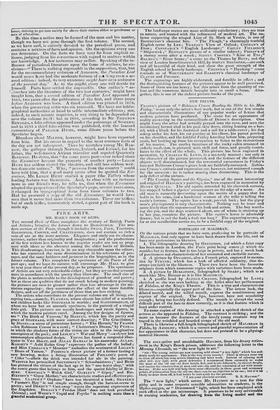FINE ARTS.
MR. HALL'S 11001i oF GEMS.
THE second Book of Gems completes the century of British Poets and Artists; bringing the former down to BLOOMFIELD. The mo- dern section of the Poets, though it includes SWIFT, POPE, THOMSON, GOLDSMITH, COWPER, and CHATTERTON, does not contain SO rich a vein of ore as the more ancient. Elegance and study are its charac- teristics, rather than originality and imagination ; and the productions of the few writers less known to the popular reader are not so preg- nant with ideas as the obscurer among the elder bards of Britain. This disadvantage, however, is in no way chargeable upon the editor; who has exercised the same discrimination in his selections of pas- sages, and the same boldness and justness in the biographies, as in the former volume. This completes the specimens of the Poets of the past age; and we hope its success will encourage Mr. HALL to give us next year those of the present day, as he proposes. The specimens of Artists are not very remarkable either ; but they are on that account more in accordance with the poetry they illustrate. The small size of the plates is unfavourable to the development of grandeur and power ; but as these are qualities that do not much belong to modern painting, the pictures are seen to greater rather than less advantage in the mi- Mature engravings: they concentrate the effect of the more forcible designs, and set off the prettiness of those that are less striking: The artists who contribute to the present volume are all living, ex- cepting two,—namely, FLAXMAN, whose classic bas-relief of a mother and children looks like STOTHARD in marble; and Garsmottoucti, of whom we have but an uncouth specimen, in the portrait of a stupid little girl. The pictures are mostly landscapes and rustic figures, in which the modern painters excel. Among the few designs of figures, are" The Birth of Vanessa," by IlAavrs, which has the poetry and grace of SrornAno, with more correct drawing; " The Crucifixion," by DANBY—a scene of portentous horror ; 6' The Hermit," by FaAsEn rlis Robinson Crusoe in a cowl ; " Chatterton's Dream," by PYNE- in which the shadowy forms of the vision are akin to the imaginative conception of the poet ; and LESLIE'S " War and Mercy"—a clever but commonplace allegorical design. YOUNG has found a congenial illus- trator in VON HOLST, and ALLAN RAMSAY in his namesake ALLAN. KNIGHT'S " Auld Robin Gray" expresses the pathos of the ballad ; and Miss Coanaux's " Mourner " embodies the sentiment of LOGAN'S 4' Braes of Yarrow." PIDDING'S clever picture of a farmer tasting a new brewing, makes a fitting illustration of PHILLIPS'S poem of " Cider "—albeit the drink was intended for ale in the painting. WEBSTER has personified SHENSTONE'S " Schoolmistress ;" and Buss Las pictured the citizen of the last age in his "one-horse shay," with the comic gusto that belongs to him, and the quaint fidelity of BUN- FAIRY. CRISTALL'S " Welsh Girl," OAKLEY'S " Gipsy," and Ro- fiRTSON'S "Gipsy Mother," are characteristic studies and effective pic- tures. CLATER'S " Orphans" have too theatrical a look ; SHAYER'S " armer's Boy" is not simple enough, though the harvest-scene is pretty; and DERBY'S" Cast-away" wants the repentant expression of the Magdalen. BOXALL'S " Persian Maid" does not look peculiarly Oriental ; and WOOD'S" Cupid and Psyche " is nothing more than a graceful academical group. The landscape scenes are more uniformly satisfactory ; they are true to nature, and treated with the refinement of modern art. The co- lumn supporting the winged Lion of St. Mark at Venice, is one of BONINGTON'S choicest bits. "The Plcugh," a charmingly truthful English scene by LEE; VICKERS'S View of Oxford ; COTMAN'S Of Eton ; CONSTABLE'S " English Landscape ;" COPLEY FIELDING'S "Shipwreck ;" BENTLEY'S picture of a similar subject ; PRIEST'S Of a stormy scene after a wreck ; SIDNEY COOPER'S " Eine at Eve ;" BALMER'S "River Scene ;" a scene on the Thames by BOYS; and the view of London fromGreenwich Hill, by SIDNEY SIIEPHERD,—are each and all beautiful of their kind, and show the great strength of the English school in homely landscape. CRESWICK'S " Hawking" scene reminds US Of WOUVERMANS' and Baititurr's classical landscape of CLAUDE and POUSSIN.
The engravings are highly elaborated, and forcible in effect ; and the distinguishing features of the pictures appear to be well preserved. Some of them are too heavy ; but this arises from the quantity of co- lour and the numerous details brought into so small a focus. Alto- gether, this is one of the richest picture-books of the year.


























 Previous page
Previous page